St. Kieran (Ciaran) of Saighir, or St. Kieran the Elder, is also called “the first-born of the Irish saints”. He was born in the fifth century in the Irish kingdom of Ossory and was related to the royal family. His father Luaigne was from Ossory, and his mother Liadan came from Cork. When Liadan was pregnant, she had a dream that a star fell from the sky and rested on her, which was understood as a sign that her infant would have a special role in the history of the Irish Church. Everybody saw brightness and holiness in little Kieran and he was loved by all. He was very kind, humble, inquisitive, loved animals, but first of all wanted to be closer to God. Various traditions connect him with different saints, which is not always chronologically correct, so the connection would have been spiritual, not physical.
Kieran may have been a disciple of St. Finian of Clonard under whom he may have studied. In his youth Kieran spent some time in continental Europe where he was ordained a priest. He probably studied in Gaul (at Tours) and Rome. On his return to Ireland, according to tradition, St. Patrick, the enlightener of the emerald isle, consecrated him the first Bishop of Ossory, where he preached the Gospels and has been venerated from time immemorial. Later the saint settled in the forests of the kingdom of Ossory where he lived in a tiny cell as a true anchorite in Saighir near the Slieve Bloom mountains. According to his biographer, St. Patrick gave him a bell saying that this bell would only ring on the spot where by the will of God Kieran would eventually found a great spiritual center—and this spot was Saighir.
By a spring, the ascetic built a cell of wattle and thin branches smeared with mud, and the roof was of grass and leaves. His diet consisted only of herbs and barley bread once a day, and he drank only water. Some years passed. With time numerous disciples started flocking to the ascetic who became famous for his miracles. And Kieran founded the large monastery of Saighir on the site of his hermitage—not far from Birr in present-day county Offaly—and became its first abbot. Many future saints lived in this monastery, which became a center of learning and preaching.
The place where the monastery was situated—Saighir—most probably means “the fountain of Kieran”. The holy man taught his brethren and led all those under his care to spiritual perfection, setting them a good example in his life. Some while later the saint’s mother Liadan, together with many other pious women, moved to live a holy and God-pleasing life near her son’s monastery. One early source states that Kieran himself founded a community for women close to his main abbey. The monastery of St. Kieran at Saighir also became the place of burial of the kings of Ossory in Ireland. The veneration of St. Kieran was so strong that a perpetual fire was maintained in Saighir Abbey in his memory for many years after his repose.
St. Kieran was a celebrated ascetic. Sometime during his life he lived as a hermit on the island of Cape Clear in Munster Province (now in County Cork), spending all his time in unceasing prayer. There are also stories relating his life in a cave. St. Kieran is listed among “the Twelve Apostles of Ireland”; that is, the saints who studied at Clonard Monastery, though it is impossible to prove that all of them were in fact monks there. Kieran in his spiritual labors imitated the feats of the Desert Fathers and especially St. John the Baptist, and, like many of them, he wore animal skins and slept on the ground. Angels were his companions and helpers from childhood throughout his life. His biographers said that the saint lived a life of prayer, fasting and abstinence, and that he overcame the devil and made friends with those who dwell in heaven.
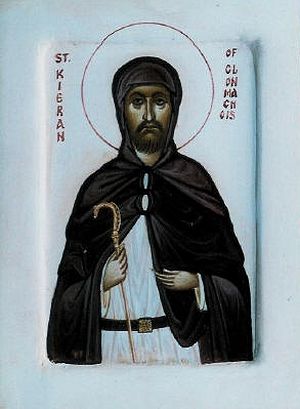 An icon of St. Kieran of Clonmacnoise
An icon of St. Kieran of Clonmacnoise
Among the miracles performed by this saint of God we should mention raising several people from the dead through his intercessions. As a boy the saint once saw a hawk seizing a defenseless baby bird from its nest. Little Kieran felt pity for the nestling, prayed for it, and the bird of prey suddenly fell down and laid the baby on the ground at his feet. The nestling looked almost lifeless: Kieran prayed again, and the bird was restored to health. There lived a holy abbess named Cuach many miles away from St. Kieran’s Monastery. She had been his nurse in his childhood. And it was noticed that the holy abbot Kieran miraculously visited his former nurse every year on Christmas night and gave her communion; after that he speedily returned to his brethren to celebrate in some miraculous way. One of his contemporaries suggested that each time Kieran was carried to and from his nurse’s convent by angels, like the holy prophet Habakkuk, whom an angel by the grace of God lifted by his hair and took him “by air” to Babylon to give food to the prophet Daniel in the lions’ den.
Once the saint blessed a holy well so that it had the flavor of wine and honey. From that time on all who drank from this well felt filled.
One day a venerable abbot paid a visit to Kieran’s monastery. The brethren invited him to dinner. But it was extremely cold in the abbey that day. St. Kieran prayed to God for at least a little heat, and a fireball descended and the fire sufficed to heat up the refectory with the abbot, the guest and all the monks. One day St. Patrick came to St. Kieran’s monastery and some nobles with him. But there was a shortage of food at the abbey. Kieran prayed and the supplies of food miraculously multiplied at once. Another legend relates that a war broke out between two kingdoms in Ireland. The opposing parties met near a brook close to Kieran’s monastery. The saint showed himself to be a peacemaker: he went out and tried to persuade each party not to fight; but they were stubborn. Then he started praying, and the brook became so swollen that it turned into a wide river so that the armies could not fight with each other at all. Only then, following this miracle did they come to their senses and decide to stop the war.
According to tradition, St. Kieran till the end of his life served as Bishop of Ossory and Abbot of Saighir, tirelessly ministering to the people and working miracles. Afterwards a whole town grew up around his monastery. St. Kieran of Saighir should be distinguished from his famous namesake: St. Kieran of Clonmacnoise, or St. Kieran the Younger, who lived approximately at the same time as him. Kieran of Saighir reposed in the Lord in about the year 530. By that time his fame had spread all over Ireland, though he did not seek fame, but cared only for service to the Lord and people. On the day of his repose many monks and bishops gathered at his death-bed. Kieran blessed them and asked them to love each other and the monastery, to keep unity and piety and to remember the temptations of our common enemy. The saint also asked them to pray for him, and predicted that the time would come when the faith would be distorted and the monasteries would be destroyed (indeed that was fulfilled after the Anglo-Norman Conquest and at the Reformation).
After his demise, the veneration of St Kieran spread rapidly all over the emerald isle and he has been commemorated in all its dioceses since ancient times. His monastery became the center of the Diocese of Ossory for several centuries (consequently the see was transferred to Aghaboe and later to Kilkenny). Saighir Abbey prospered until the eleventh century despite several attacks by the Vikings, and after the Norman Conquest it was occupied by Augustinians in 1170. The Augustinian priory was closed in the sixteenth century and monastic life here stopped, though the atmosphere of holiness (even among the ruins) still reigns.
The saint was often depicted with a fox, a doe or a badger. Today pilgrims can visit the ruins of Saighir Monastery. The village where the monastic remains are located is called Clareen, in County Offaly. The stump of the tenth-century monastic round tower and the base of a Celtic decorated “high cross” can be distinguished there, along with a holy well (whose water heals headaches) and a “holy tree” connected with the saint. According to local residents, even water that gathers in the cross base cures warts, and a stone lying near the tree has marks of the knees of the saint who supposedly prayed on it! In the nineteenth century a new Anglican Church (Church of Ireland) in honor of St. Kieran was built there right near the ruins, and it incorporates some stones from the ancient structure. Every year on March 5, Catholic believers organize processions to these holy sites linked with Kieran. Ruins of an ancient church and an early holy well can be found on Cape Clear Island where the saint lived as a hermit. It is said that the saint built this church himself. Part of a very early cross can also be seen there. This isle is virtually the most southerly populated area in Ireland. Its present population is about 100 people. According to tradition, St. Kieran was born precisely on this island or near it. There are ruins of the early medieval St. Kieran’s Church, a holy well and a bush connected with the saint in the village of Errill in County Laois. Tradition holds that the saint built a monastery there.
Today he is the patron-saint of the Roman Catholic Diocese of Ossory in Ireland and is venerated by many Christians, including Orthodox. Outside Ireland this saint is venerated in Wales (where, according to a legend, he visited St. Illtud and preached), in England, Scotland and Brittany.
Holy Father Kieran of Saighir, pray to God for us!

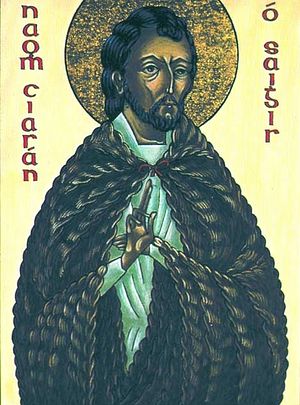
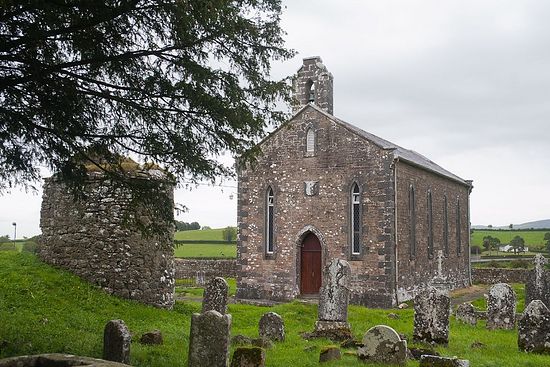
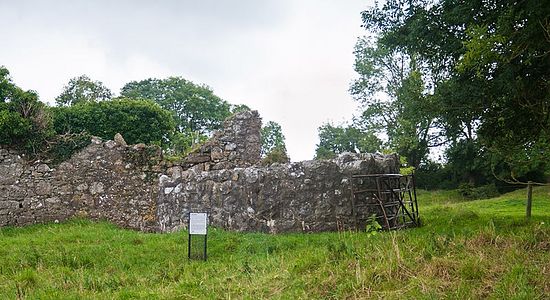
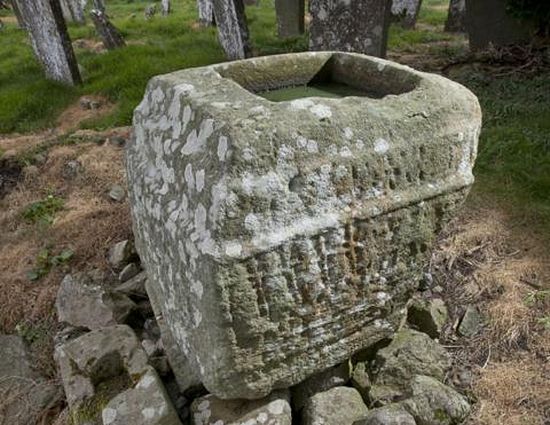
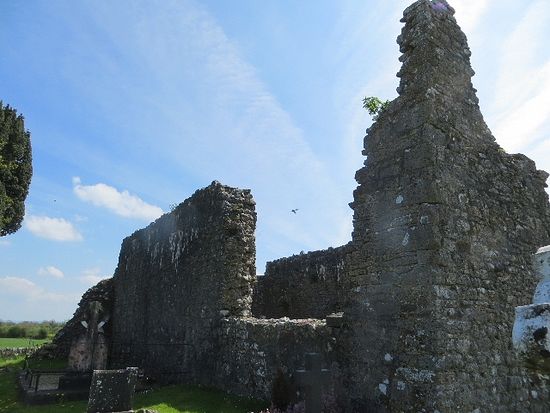
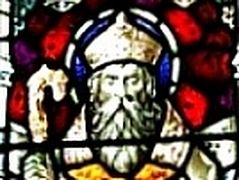
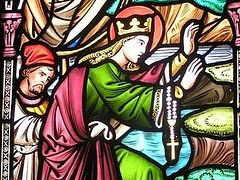
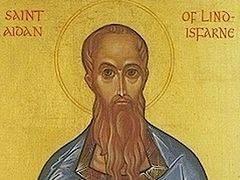
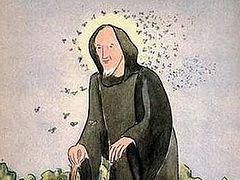
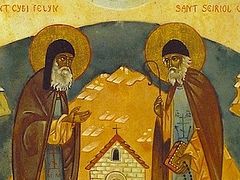
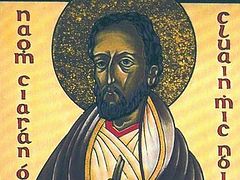
Yes, it was me who replied to your first comment.
I'd like to express my deep gratitude to you for your kind and sincere words! We are really pleased that you enjoy reading our articles on these early saints of the British Isles and Ireland!
Is this the Dmitry Lapa that posts all of these wonderful articles of Orthodox Western saints? If so I owe you such an immense debt of gratitude! This is such an important thing for us in the West to see. God bless your efforts for this! May you have the prayers of these holy intercessors!
So often we Orthodox in the West can be made to feel like Orthodoxy is "exotic" but in fact your articles show that the essence of the Church is universal. Of course one reads about this in theory, but your articles are objective examples of this fact that educate people like me! Please, please continue!
The top icon in the article is indeed that of St Kieran of Saighir, it is even indicated on the icon itself. The lower icon is of St Kieran of Clonmacnoise who is also mentioned in the article - and that is indicated in this icon too. So there is no mistake here.